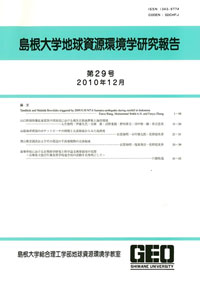島根大学総合理工学部地球資源環境学教室
ISSN:1343-9774

ダウンロード数 : ? 件
この文献の参照には次のURLをご利用ください : https://ir.lib.shimane-u.ac.jp/6134
島根大学地球資源環境学研究報告 22
2003-12-27 発行
中海における過去約40年間の貝形虫(甲殻類)の群集変化
Faunal changes in Ostracoda(Crustacea)in Lake Nakaumi,southwest Japan,over the last 40 years
ファイル
内容記述(抄録等)
Sixty−five ostracode species were obtained from 37 sufuace sediment samples collected from Lake Nakaumi between August 5 to 8,2002.The most dominant species is Bicornucythere bisanensis.This species is abundant in the central part of the lake,where oxygen-poor bottom waters develop in summer.Dolerocypria mukaishinense and Cytherura miii are sporadically dominant in relatively low-salinity environments such as river mouths and the Honjo-koku area.Other species are rare except at the lake mouth,where high-diversity assemblages composed of 47 shallow brackish to marine ostracode species are recognized.To clarify the relationships between ostracode assemblages and human activities over the last 40 years,particularly reclamation and freshening projects,we compared published ostracode studies of Lake Nakaumi,based on samples collected in 1963/1967 and 1986,with our present results.Six ostracode assemblages are distinguished on the basis of Q-mode cluster analysis.Ostracode assemblages and their distribution areas changed dramatically between 1963/1967 and 1986,related to change in pattern of bottom water circulation.In contrast,they have changed little at from 1986 to 2002,although the areas dominated by B.Bisanensis seem to be slightly enlarged.
Other Article
PP. 93 - 105
PP. 107 - 110
PP. 111 - 120
PP. 121 - 133
PP. 161 - 166
PP. 167 - 172
